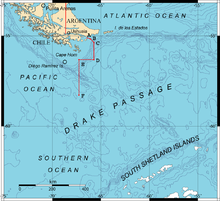
Back Drakedeurgang Afrikaans ممر دريك Arabic Pasaxe de Drake AST Dreyk boğazı Azerbaijani Дрейк боғаҙы Bashkir Праліў Дрэйка Byelorussian Пратока Дрэйка BE-X-OLD Дрейк (проток) Bulgarian ড্রেক জলপথ Bengali/Bangla ཏི་རེ་ཁི་མཚོ་འགག Tibetan



The Drake Passage is the body of water between South America's Cape Horn, Chile, Argentina, and the South Shetland Islands of Antarctica. It connects the southwestern part of the Atlantic Ocean (Scotia Sea) with the southeastern part of the Pacific Ocean and extends into the Southern Ocean. The passage is named after the 16th-century English explorer and privateer Sir Francis Drake.
The Drake Passage is considered one of the most treacherous voyages for ships to make. Currents at its latitude meet no resistance from any landmass, and waves top 40 feet (12 m), giving it a reputation for being "the most powerful convergence of seas".[1]
As the Drake Passage is the narrowest passage (choke point) around Antarctica, its existence and shape strongly influence the circulation of water around Antarctica and the global oceanic circulation, as well as the global climate. The bathymetry of the Drake Passage plays an important role in the global mixing of oceanic water.
- ^ "6 men become 1st to cross perilous Drake Passage unassisted". AP NEWS. Associated Press. 2019-12-28. Retrieved 2020-10-30.
© MMXXIII Rich X Search. We shall prevail. All rights reserved. Rich X Search